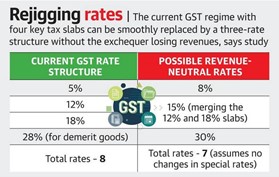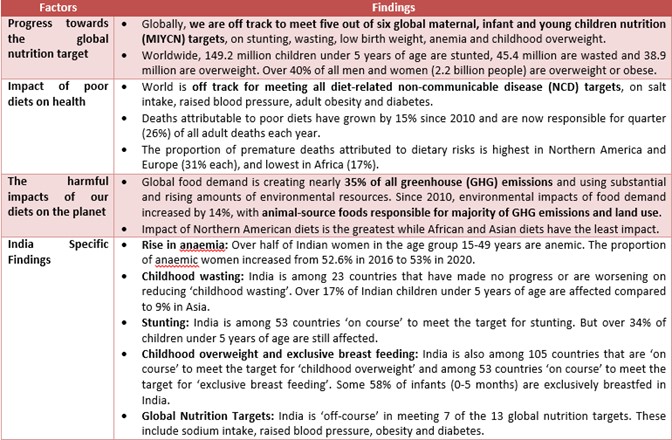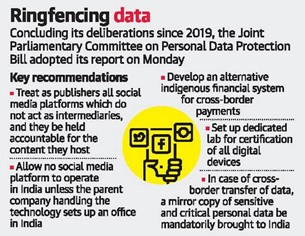Monday, 29th November 2021
Highway audit
In News
An audit initiated by the government to reduce fatalities on National Highways revealed that 40% of fatal accidents on highway stretches occur due to rear-end collisions.
About the News
- A pilot audit of data was done on four highway stretches in Uttar Pradesh and Maharashtra.
- The four audited stretches had witnessed over 6,500 accidents over the past three years, of which over 1,600 were serious and fatal ones.
- Save Life Foundation, a nongovernmental organization, conducted the audit.
Details of the Audit
- Rear –end Collisions: Rear-end collisions account for around 40 per cent of fatal accidents on highway stretches, with driver “sleepiness and fatigue” behind many of these crashes.
- A rear-end collision is a traffic accident wherein a vehicle crashes into the vehicle in front of it, and it happens to be one of the most common types of crashes in the world.
- Fatigue as the Reason: Auditors examined medical records of trauma care and data from highway concessionaires and found that fatigue, especially among commercial vehicle drivers, led them to crash into stationary vehicles or slow-moving vehicles from behind.
- Engineering defects: The study also found several engineering defects such as gaps in medians, missing crash barriers, concrete structures kept along the road, all of which added to accidents and resultant fatalities.
- Reasons for accidents: According to the audit, apart from usual deficiencies such as drink driving, riding without helmets, lack of proper illumination in some stretches, lack of enforcement by state governments also contributed to accidents.
- Local factors: Stretches in Uttar Pradesh had a lot of accidents occurring due to lack of visibility in the winter months.
- Maharashtra had the problem of “hydroplaning” in the monsoon months leading to vehicles going out of control.
- Hydroplaning is a dangerous driving condition that occurs when water causes your car's tires to lose contact with the road surface.
Impact of the Road accidents
The World Bank Report titled “Traffic Crash Injuries and Disabilities: The Burden on India Society”, prepared in association with the NGO – Save Life Foundation says that road accidents are a tremendous burden to society and the nation as
- Reducing road accident deaths and injuries can boost income growth.
- Large welfare gains can be achieved from proven cost-effective road safety interventions
- Road accident deaths and injuries strike down prime working age adults in low and middle-income countries.
- Road accidents are a public health issue and challenge in countries like India.
- India witnesses around 5 lakh road accidents and 1.5 lakh deaths from them every year.
- ‘4Es’ of improving road safety: Engineering, Education, Enforcement and Emergency care services help in reducing road accident deaths.
Where can it be used?
- Road Accidents, Road problems, Infrastructure
Sources:
- 40% fatal crashes due to rear-end collisions: highway audit
- Gadkari says vehicle manufacturers should provide basic safety features in vehicles at minimum affordable price; releases World bank report which says large welfare gains can be achieved by cost-effective road safety interventions
- Why your Car Hydroplanes, and What to Do When It Happens
Pradhan Mantri Awaas Yojana- Gramin
In News
Pradhan Mantri Awaas Yojana – Gramin (PMAY-G) has completed 5 years.
About the News
- PMAY-G is one of the flagship programmes of the Government of India launched in 2016 with the objective of providing “Housing for All” by 2022.
- The program envisages the completion of 2.95 crore PMAY-G houses with all basic amenities by the year 2022.
Significant Features of the Scheme
- Social Welfare Program: It is a social welfare program through which the Government provides financial assistance to houseless beneficiaries identified using SECC 2011 data to help them construct a house of respectable quality for their personal living.
- Financial Aid: The cost of the unit will be shared in a 60:40 ratio between the Central and State governments in plain areas, i.e., Rs.1.20 lakh of assistance for each unit.
- In the Himalayan states, northeastern states, and the Union Territory (UT) of Jammu & Kashmir, the ratio is 90:10 with up to Rs.1.30 lakh of assistance for each unit.
- 100% financing from the Centre for Union Territories including the UT of Ladakh
- Payment System: Payments are made electronically directly to bank accounts or post office accounts that are linked to Aadhaar.
- Convergence with other schemes: Convergence for piped drinking water, electricity connection, LPG gas connection etc. under different Government programmes Swachh Bharat Mission, PM Ujjwala Yojana etc. and unskilled wage component of 90-95 days under MGNREGS. is also an inherent thematic component of the scheme.
- Monitoring through E- Governance: The program is being implemented and monitored through end to end e-governance solutions such as AwaasSoft and AwaasApp.
- AwaasSoft: Provides functionalities for data entry and monitoring of multiple statistics (such as registrations, sanctions, house completion, release of instalments, financial progress, status of convergence etc.) related to implementation of the scheme.
- Landless Module: To map landless beneficiaries in the permanent waitlist PWL and to capture the status of availing land or financial assistance for land purchase to the landless beneficiaries, a module on landless has been developed. The module captures the status of land provided to landless beneficiaries either financially assisted or provided land physically.
- E-Ticketing system: The module has been introduced to address the grievances pertaining to technical as well as non-technical issues under PMAY-G as referred by the State/UTs.
- Adhaar Based Payment System: It allows Direct Benefit Transfer (DBT) to the PMAY-G beneficiary in his/ her bank account linked with the Aadhaar number of the concerned beneficiary for the safe and authentic transaction.
- iGOT: A module on understanding the features of PMAYG, from design to execution, is available on iGOT-an e-learning platform intended for the capacity building of stakeholders of PMAY-G.
What have been the Challenges to the PMAYG due to Covid-19?
- Government’s flagship rural housing programme is suffering a serious financial setback as cash-strapped state governments have refused to release their share of funds.
- At least nine states had not released their requisite share to the tune of Rs. 2,915.21 cr for the Pradhan Mantri Awas Yojana (Gramin) in the year 2020.
- Construction work under the programme has suffered with lockdowns drying up all sources of revenue and states holding back their share. Against a target of 6.15 million houses, only 755,000 have been sanctioned this financial year and just 559 completed.
- Besides their share, some states also had not released central government funds for the programme. The rural development ministry releases funds to a state nodal account (SNA) from where they are transferred to beneficiaries.
Where can it be used?
- Government Schemes, Economy, Societal Benefits
Source:
Corporate Ownership of Banks
In News
Reserve Bank of India (RBI) has refrained from allowing the corporate ownership of banks.
About the News
- About the Decision: This decision of the RBI puts on hold the recommendations from its internal working committee - that said large corporate and industrial houses may be allowed to promote banks after amendments to the Banking Regulations Act, 1949.
- The main reason behind this decision is the fears over connected lending and self-dealing if they are allowed in the banking space.
- The central bank has also not accepted the recommendation to allow well-run, large non-banking financial corporations or NBFCs, including those owned by a corporate house, to become banks. The RBI said that both suggestions are under examination.
- Recommendations of the IWG: The initial recommendations by the internal working group were - allowing well-run large NBFCs with an asset size of ₹ 50,000 crore and above, including those owned by corporate houses, may be permitted to convert to banks provided they complete 10 years of operations and meet the due diligence criteria.
- What’s Allowed?: However, the central bank has allowed promoters to retain a 26 per cent shareholding in banks, higher than the current cap of 15 per cent.
- The move will benefit leading private lenders such as Kotak Mahindra Bank and IndusInd Bank, among others, which have been seeking more time from the regulator to divest their stakes for many years now.
- The RBI also accepted the recommendation that promoters can hold a minimum 40 per cent stake in private banks during the lock-in period - first five years.
- History of Licensing: Since the nationalization of 14 large private banks in 1969, the RBI has not given licenses to large corporate and industrial houses for setting up banks.
Arguments in Favour of granting banking license to big corporate houses
- They can bring in capital and business experience: The total balance sheet of banks in India still constitutes less than 70 per cent of the GDP, which is much less compared to global peers.
- Financial inclusion: It will promote financial inclusion by opening more branches.
- Greater competition: The entry of corporate players would engender greater competition in the Indian banking sector.
Arguments against granting of banking license to big corporate houses
- Conflict of interest: This may lead to “connected lending” without proper scrutiny, leading to an increase in NPA.
- Connected Lending refers to a situation where the promoter of a bank is also a borrower and, as such, it is possible for a promoter to channel the depositors’ money into their own ventures. It leads to conflict of interest and moral hazard, eventually leading to growth in NPA and corruption.
- Poor quality of corporate governance practices: It is another key reason why the RBI has not issued banking licenses to corporate houses.
- Lack of regulatory capacity for real time tracking: Recent frauds has caste doubts over the capacity of RBI to track connected lending, circular banking, loans to front companies controlled by corporates, loans to suppliers and vendors of a corporate group, creation of fictitious loan accounts, “evergreening” of loans, and other fraudulent practices on a real-time basis.
Where can it be used?
- Economy, RBI, Banking Reforms, Bank Licesing, Corporate ownership of Banks
Source:
Partition of Palestine
ON November 29, 1947 the United Nations General Assembly adopted Resolution 181 (II) calling for the partition of Palestine into two separate states—Arab(Palestine) and Jews(Israel)—that would retain an economic union. The Jewish Agency for Palestine accepted the resolution but Arab leaders and governments rejected it. They were adamant to accept any form of territorial division as it violated the principles of national self-determination in the UN Charter. The right of the citizen to choose their own destiny. A civil war broke out soon after the adoption of the Resolution by the General Assembly and thus it was not further implemented. Even 73 years later, the conflict between Israel and Palestine is ineffable virulent and land of the post-colonial massacre.

Sources:
SATH-E Initiative
In News
NITI Aayog has suggested measures through the SATH-E Initiative to improve the India’s school education system, especially learning outcomes, for effective implementation of National Education Policy, 2020.
About the SATH-E Initiative
- Project SATH-E, ‘Sustainable Action for Transforming Human Capital-Education’, was launched in 2017 to identify and build three ‘role model’ States for the school education sector. After an elaborate selection process, Jharkhand, Odisha and Madhya Pradesh were chosen.
- In collaboration with knowledge partners - Boston Consulting Group and Piramal Foundation, SATH-E champions a systemic approach to transform, which prioritizes simultaneous academic and governance reforms.
Why does India’s Education Sector need Transformative programmes like SATH-E?
Despite success in providing near-universal access to education with over 96% enrolment maintained for students in age group 6-10 years, student learning outcomes consistently reflect that universal access has not translated into improved quality of education
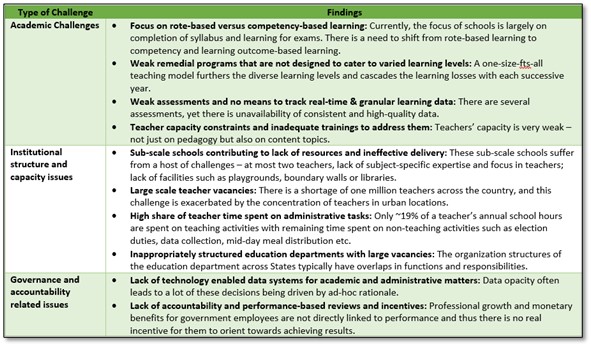
Thus, there is vast multiplicity and interconnectedness in the challenges faced by the Indian education system today. Thus, a systemic approach is essential in designing transformative reforms. There is a need to shift from small-scale pilots to State-wide implementation at-scale and from only academic to a combination of academic, institutional and governance reforms.
The SATH-E initiative has proposed the following Transformative Framework
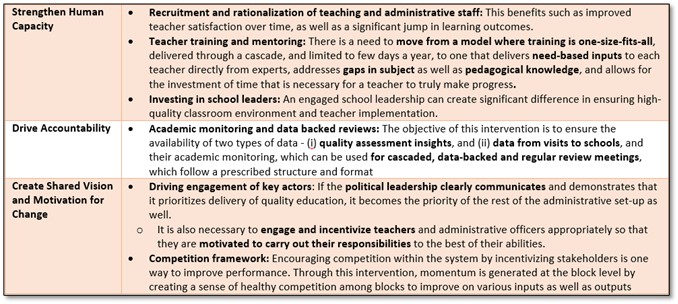
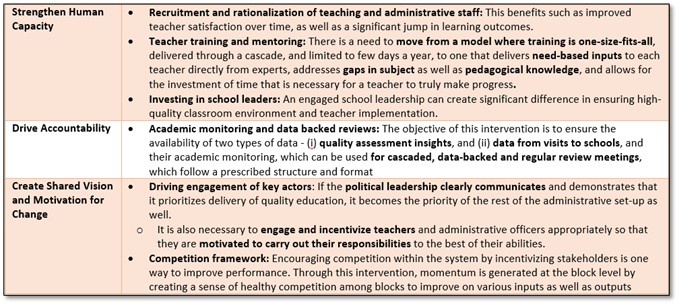
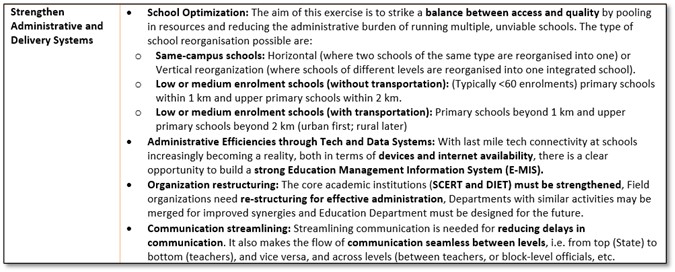
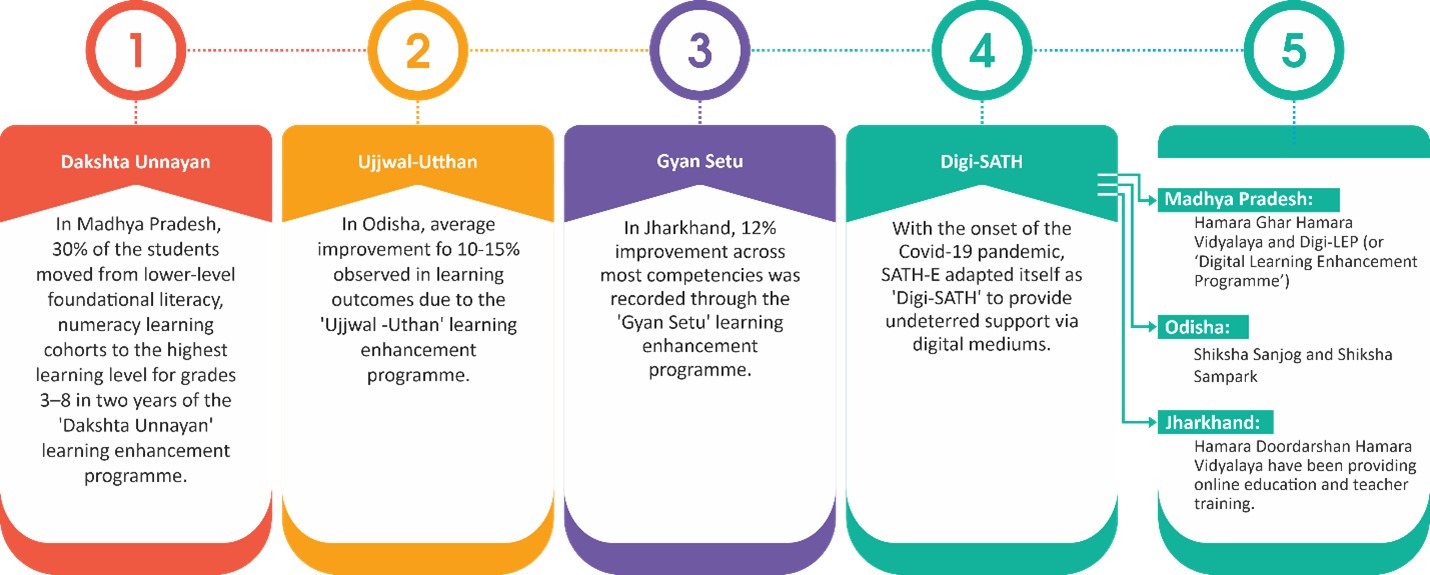
Conclusion: As a country, the challenge we now face is to ensure the delivery of quality education. The complexity of carrying out this task requires a shift in the approach we have taken till now. There is a need for a comprehensive strategy that combines elements of both Academic and Governance reforms, to ensure systemic and sustained progress towards improving learning outcomes of students. Successful systemic transformation requires a well-laid out roadmap with pre-defined targets, the alignment of all stakeholders around a unified vision, efficient communication channels, a culture driven by data-based accountability and a continuous process of capacity building across all levels.
Question:
Discuss the challenges being faced by the Education system in India. What can be the possible interventions to resolve these challenges?
Where can it be used?
- Education Reforms, NITI Aayog’s role in Education, SATH-E initiative
Sources:
Omicron
This is the first image of the Omicron variant of Covid-19 virus. This first photo of Omicron shows the structure of the spike protein of the Omicron variant, on the right, and of the Delta variant, on the left, compared to the original SARS CoV-2 spike. The image reveals that majority of mutations have been found to have occurred in the area that interacts with human cells. Now it is up to vaccine scientists to tell whether this revelation throws any light on how the human body will react to the increased number of mutations on the coronavirus' spikes -- the exact area that acts as a key in unlocking the human cells for the virus to gain entry and take over. First detected by scientists in South Africa and identified as a “variant of concern” on Friday by the World Health Organization (WHO).
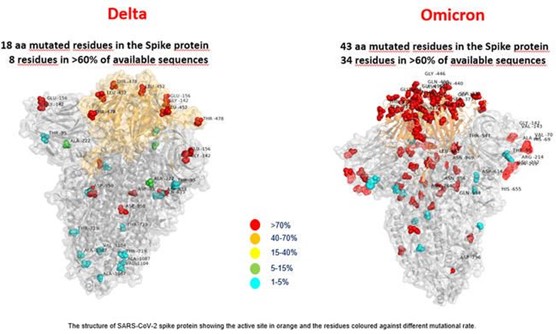
Sources:
O-SMART Scheme
- Context: The Cabinet Committee on Economic Affairs has given its approval for continuation of the umbrella scheme "Ocean Services, Modelling, Application, Resources and Technology (O-SMART).
- The scheme aims to step up ocean research and set up early warning weather systems and is implemented by the Ministry of Earth Sciences.
- It addresses ocean development activities such as services, technology, resources, observations and science and provides necessary scientific and technological background for implementation of various aspects of Blue Economy.
- The scheme encompasses seven sub-schemes namely:
- Ocean Technology
- Ocean Modelling and Advisory Services (OMAS)
- Ocean Observation Network (OON)
- Ocean Non-Living Resources,
- Marine Living Resources and Ecology (MLRE)
- Coastal Research and Operation and
- Maintenance of Research Vessels.

Source:
- Cabinet approves continuation of the umbrella scheme "Ocean Services, Modelling, Application, Resources and Technology (O-SMART)"
- Ocean Services, Modelling, Applications, Resources and Technology (O-SMART) SCHEME of the Ministry of Earth Sciences
Image Source:
ACROSS scheme
- Context: The Cabinet Committee on Economic Affairs has approved Rs 2,135 crore for the continuation of ACROSS scheme.
- Atmosphere & Climate Research-Modelling Observing Systems & Services (ACROSS) scheme aims at further enhancing and upgrading the country’s weather forecasting and climate services along with providing latest computing capabilities and infrastructure.
- Its objective is to provide improved weather, climate, ocean forecast and services, and other hazard related services and ensure the transfer of equivalent benefits to the end user.
- Under this scheme, eight sub-schemes will be implemented through various organisations like India Meteorological Department (IMD), Indian Institute of Tropical Meteorology (IITM), Indian National Centre for Ocean Information Services (INCOIS) etc.
- As the whole process from generation of forecast to its delivery requires considerable manpower at every stage, the scheme generates employment opportunities to many people.
- The scheme is implemented by the Ministry of Earth Sciences (MoES).
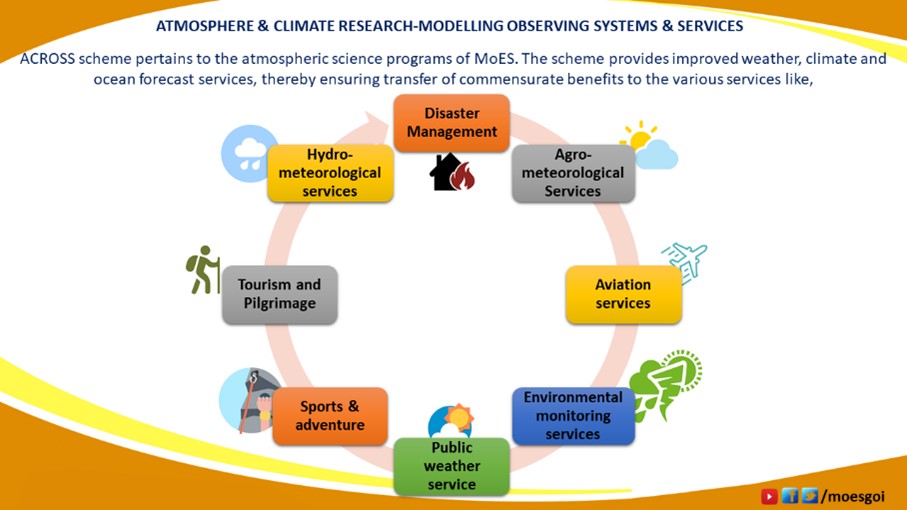
Source:
- Central government approves Rs 2,135 crore for improving weather forecasting services
- Cabinet approves Continuation of the umbrella scheme "Atmosphere' & Climate Research-Modelling Observing Systems & Services (ACROSS)" from the 14th Finance Commission to the next Finance Commission Cycle (2021-2026)
Image Source:
INS Vela
- Context: INS Vela, the fourth submarine of P75 of the Indian Navy has been recently commissioned at the naval dockyard.
- Project 75 is a submarine acquisition project conceptualised at the time of the IK Gujral government.
- Vela is a diesel-electric powered attack submarine, designed to act as “sea denial” as well as “access denial” warfare to the adversary.
- The submarine can engage in offensive operations across the entire spectrum of naval warfare, including anti-surface warfare, anti-submarine warfare, intelligence gathering, mine laying and area surveillance.
- It is named after a decommissioned submarine Vela, which served the Navy from 1973 to 2010.
- The carrying capacity of the submarine is that can take up to eight officers and 35 men.
- It is equipped with C303 anti torpedo countermeasure system, and can carry up to 18 torpedoes or Exocet anti-ship missiles or 30 mines in place of torpedoes.
- Vela is the fourth submarine of P75, the others being Kalvari, Khanderi and Karanj.
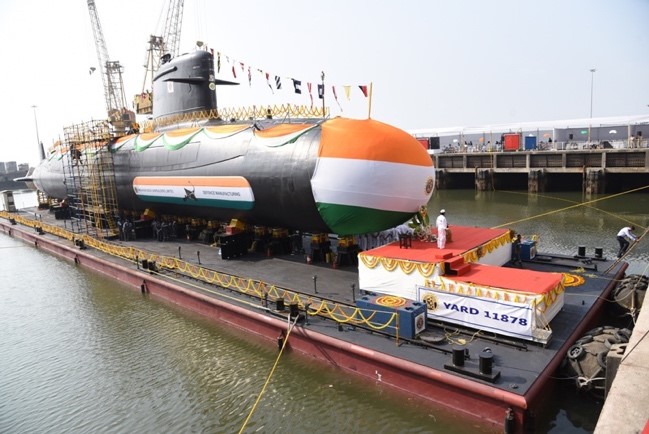
Source:
- Explained: What is INS Vela, the submarine commissioned by Indian Navy?
- Fourth Scorpene class submarine INS Vela joins Navy
Image Source:
Exercise Dosti
- Context: The 15th edition of exercise ‘Dosti’ is underway in the Maldives.
- Exercise Dosti is a biennial trilateral coast guard exercise involving India, the Maldives and Sri Lanka.
- The exercise was launched as a bilateral exercise between the Indian and the Maldives Coast Guards in 1991 and Srilanka joined in 2012.
- The aim of the exercise is to further fortify the friendship, enhance mutual operational capability for search and rescue operations, combating piracy and armed robbery, damage control and casualty evacuation at sea for safer seas, exercise interoperability and to build cooperation between the Coast Guards of the three nations.
- Indian Coast Guard vessels, the ICGS Vajra and ICGS Apoorva joined the Sri Lanka Coast Guard, SLCGS Suraksha for the exercise.

Source:
- Explained: What is INS Vela, the submarine commissioned by Indian Navy?
- Fourth Scorpene class submarine INS Vela joins Navy
Image Source:
Taking India Stack to the next stage: HBL
Essence: The article highlights the achievement of India for soon to becoming the one of the largest digital markets in the world. The rate of adoption of fintech in India is 87 per cent as against the global average of 64 per cent. There are two evidences that support the achievement – first being the ever-improving India Stack and second the absence of a legacy system.
The elements of the country’s public digital platform that form the India Stack are unique and are set to expand India Stack’s footprint. This can be done by taking India’s experience to not only to developing countries but to developed ones also. Along with that scaling up of India’s mid-size and start-up companies can also take place through India’s public digital platforms. All this could prove to be revolutionary the way internet did on which huge fortunes like Google and Amazon was created.
Why you should read this article?
- To understand the reasons behind India becoming the largest digital markets in the world.
- To understand how the use of India Stack could be expanded around the world.
Source:
Effective functioning of Parliament is sine qua non for a functional democracy: HT
Essence: As the Winter Parliamentary session is to begin today, the author points out various aspects which are hindering efficient functioning of Parliament. Some of them include less number of meetings, frequent disruptions of the session, lack of opportunity before opposition to raise issues and reducing parliamentary scrutiny of the bills. Article suggests that the rules of parliamentary procedure need to be overhauled to encourage debate and enable Parliament to do its job of rigorously examining bills as a legislature effectively.
Why should you read this article?
- To understand various challenges in working of the Indian Parliament (GS 2).
- Comparison of the working of Indian Parliament with other democracies which can be used as case studies.
Source:
How to win over Kashmiri Youth: TH
Essence: Kashmir has been on the boil since Independence. The article discusses the history of unrest in Kashmir with the spill-over of radicalised youth from Pakistan. From 1989 onwards the insurgency (from Pakistan) and counter- insurgency operations (from India) began which unfortunately created a divide between Kashmir and rest of India. But it is important to note that back then the local youth of Kashmir were not involved. It was only the Pakistanis who were the militants. The change came later in 1990s, when the Kashmiris started to be recruited as militants under threat. The due process of elections could not even save Kashmir from home grown militancy in 2008. A twin challenge for army was born- terrorists and Kashmiri youth.
In order to win over Kashmiri youth a soft touch and long-term approaches are required. A recent suggestion of lynching is not acceptable in a democratic country. Deradicalization camps, subsidised education, Operation Sadbhavna, Bharat Darshan tours are some of the steps taken as a part of soft touch policy. But the impact has not reached the real target who are from the militancy prone region. There is a need to provide protection to the Kashmiri youths outside Kashmir as well. The issue of Kashmiri Youth needs to be tackled very professionally.
Why to read this article?
- To understand the history of radicalization in Kashmir and what the twin challenge was born for the Indian Army from 2008.
- To know why certain steps have not been successful in winning over the Kashmir youth by the Indian Government and how should the issue be addressed.
- The topic is relevant from the perspective of Post-Independence Indian History (GS I) and Security Issues (GS III). It has been a boiling issue and is expected to be asked in any form in the examination.
Source:
A noble professional
Background
- Empathy benefits both, the empathetic person and the people on the receiving end of the empathetic attitude.
- In the world full of personal success and financial development, Dr Golam Ahmed Kibria of Burdwan district west Bengal is providing free medical services to the needy.

A noble person in a noble profession
- Kibria, an intern in Burdwan Medical College has been providing free medical services in the remote villages.
- Coming from a humble background, he understood the need for a good healthcare service at a minimum rate.
- He has been organizing free camps around the villages to help the poor with the funds received from philanthropist and government services.
- He has an NGO Prayag which is formed post the involvement of other doctors in the initiative.
Quote: “Health is a basic requirement for survival, like food and shelter. If doctors start reaching locals in their residential area to offer free treatment, hundreds can benefit from the same,”- Dr Golam Ahmed Kibria
Source:
Share the article
Get Latest Updates on Offers, Event dates, and free Mentorship sessions.

Get in touch with our Expert Academic Counsellors 👋
FAQs
UPSC Daily Current Affairs focuses on learning current events on a daily basis. An aspirant needs to study regular and updated information about current events, news, and relevant topics that are important for UPSC aspirants. It covers national and international affairs, government policies, socio-economic issues, science and technology advancements, and more.
UPSC Daily Current Affairs provides aspirants with a concise and comprehensive overview of the latest happenings and developments across various fields. It helps aspirants stay updated with current affairs and provides them with valuable insights and analysis, which are essential for answering questions in the UPSC examinations. It enhances their knowledge, analytical skills, and ability to connect current affairs with the UPSC syllabus.
UPSC Daily Current Affairs covers a wide range of topics, including politics, economics, science and technology, environment, social issues, governance, international relations, and more. It offers news summaries, in-depth analyses, editorials, opinion pieces, and relevant study materials. It also provides practice questions and quizzes to help aspirants test their understanding of current affairs.
Edukemy's UPSC Daily Current Affairs can be accessed through:
- UPSC Daily Current Affairs can be accessed through Current Affairs tab at the top of the Main Page of Edukemy.
- Edukemy Mobile app: The Daily Current Affairs can also be access through Edukemy Mobile App.
- Social media: Follow Edukemy’s official social media accounts or pages that provide UPSC Daily Current Affairs updates, including Facebook, Twitter, or Telegram channels.

